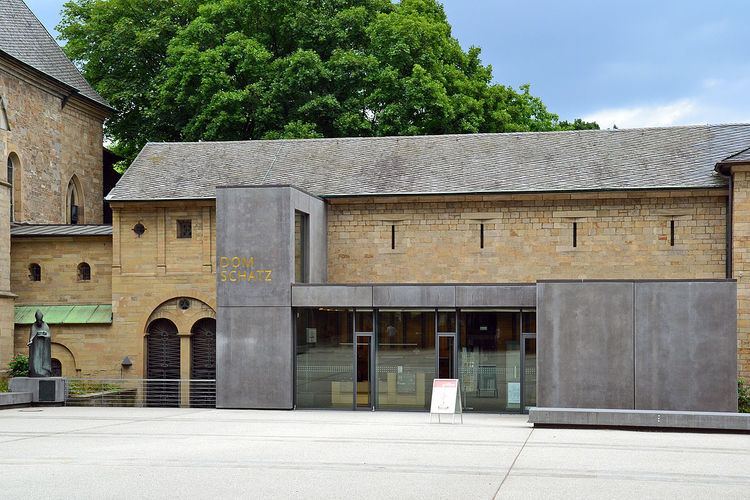Phone +49 201 2204206 | ||
 | ||
Hours Open today · 11AM–5PMWednesday11AM–5PMThursday11AM–5PMFriday11AM–5PMSaturday11AM–5PMSunday11AM–5PMMondayClosedTuesday11AM–5PM Similar Essen Minster, Ruhr Museum, Old Synagogue - Essen, Villa Hügel, Red Dot Design Museum | ||
01865 jp c
The Essen Cathedral Treasury (German: Essener Domschatz) is one of the most significant collections of religious artworks in Germany. A great number of items of treasure are accessible to the public in the treasury chamber of Essen Minster. The cathedral chapter manages the treasury chamber, not as a museum as in some places, but as the place in which liturgical implements and objects are kept, which continued to be used to this day in the service of God, so far as their conservation requirements allow.
Contents
History
The Cathedral Treasury derives from the treasury of the former Canonesses of Essen, which passed to St Johann Baptist after the secularisation of the order in 1803.
During the Ruhr Uprising in 1920, the entire treasury was smuggled out to Hildesheim in secret, from which it was returned in 1925.
During the Second World War the Treasury was taken first to Warstein, then to Albrechtsburg in Meissen and from there to Siegen, where it was sealed in Hain tunnel to protect it from aerial bombing. After the end of the war it was found there by American troops and brought to the State Museum in Marburg, and later to a collection of displaced artworks in Schloss Dyck, Rheydt. From April to October 1949, the Essen Cathedral Treasury was displayed in Brussels and Amsterdam and after that it was brought back to Essen.
In 1953 the Treasure was displayed in an exhibition in the Villa Hügel. In 1957 the Treasure became the property of the then newly established Diocese of Essen. The Treasury Chamber was first made accessible to the public without charge in 1958 at the wish of the first Bishop of Essen, Franz Hengsbach.
The Treasury had to be closed from 15 September 2008 until 15 May 2009 for a structural extension. The Treasure was displayed as the opening exhibit of the Ruhr Museum in the former coal washery of the Zollverein Coal Mine Industrial Complex from 20 October 2008 until 8 February 2009 with the tagline Gold vor Schwarz (“Gold in Black”). The new display of the Cathedral Treasure was opened on 15 May 2009, which was over seventy percent larger than the previous space and improved in line with the latest ideas in museum education.
Collection
The collection is exceptional in its completeness because only a few pieces of the Abbey's Treasure, such as the golden shrine of St Marsus have been lost in the course of time, and particularly because the liber ordinarius survives, in which the liturgical use of the objects is laid out. The Essen Cathedral Treasury contains several artistically significant works, particularly from the Ottonian period, such as:
In addition to the Ottonian artworks, valuable objects from later times also belong to the Cathedral Treasury, such as the Bust of Marsus and sixteen Burgundian fibulae from the fourteenth century. Several manuscripts also belong to the Cathedral Treasury, including the Great Carolingian Gospels (Ms. 1) of linguistical and artistic significance, the Liber Ordinarius of Essen (Ms. 19), and the Necrology of Essen (Ms. 20).
There is also a vitrine in the Treasury with loaned items from the Diocesan Museum, such as the crosier, mitres, pectoral crosses and rings of the deceased Bishops of Essen.
